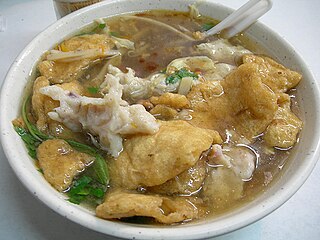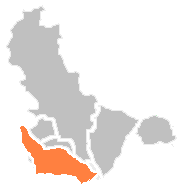
Fuzhou is the capital of Fujian, China. The city lies between the Min River estuary to the south and the city of Ningde to the north. Together, Fuzhou and Ningde make up the Mindong linguistic and cultural region.

(Chinese: 福清; pinyin: Fúqīng; Wade–Giles: Fu2-ch'ing1; Pe̍h-ōe-jī: Hok-chhiaⁿ; Foochow Romanized: Hók-chiăng; also romanized as Hokchia) is a county-level city of Fujian Province, China, it is under the administration of the prefecture-level city of Fuzhou.

Hújiāo bǐng or pepper bun is a type of baked bun that originated in city of Fuzhou, the capital of China's Fujian province. It is a street food that has become popular in Taiwan and can be found in night markets or mini food stalls throughout Taiwan. The common ingredients are flour, water, and a leavening agent for the outer dough shell, and a meat protein marinated with sugar, soy sauce, white pepper or black pepper, and scallion for the inside filling.

Buddha Jumps Over the Wall, also known as Buddha's Temptation or Fotiaoqiang, is a variety of shark fin soup in Fujian cuisine. This dish has been regarded as a Chinese delicacy known for its rich taste, and special manner of cooking. The dish's name is an allusion to the dish's ability to entice the vegetarian Buddhist monks from their temples to partake in the meat-based dish, and implies that even the strictly vegetarian Gautama Buddha would try to jump over a wall to sample it. It is high in protein and calcium. It is one of China's state banquet dishes.

Fujian cuisine or Fujianese cuisine, also known as Min cuisine or Hokkien cuisine, is one of the native Chinese cuisines derived from the cooking style of China's Fujian Province, most notably from the provincial capital, Fuzhou. "Fujian cuisine" in this article refers to the cuisines of Min Chinese speaking people within Fujian. Other cuisines in Fujian include Hakka cuisine, and the ethnic minority cuisines of the She and Tanka people. Fujian cuisine is known to be light but flavourful, soft, and tender, with particular emphasis on umami taste, known in Chinese cooking as xianwei, as well as retaining the original flavour of the main ingredients instead of masking them.

Eastern Min or Min Dong is a branch of the Min group of the Chinese languages of China. The prestige form and most commonly cited representative form is the Fuzhou dialect, the speech of the capital of Fujian.

The Fuzhou language, also Foochow, Hokchew, Hok-chiu, or Fuzhounese, is the prestige variety of the Eastern Min branch of Min Chinese spoken mainly in the Mindong region of Eastern Fujian Province. As it is mutually unintelligible to neighbouring varieties in the province, under a technical linguistic definition Fuzhou is a language and not a dialect. Thus, while Fuzhou may be commonly referred to as a 'dialect' by laypersons, this is colloquial usage and not recognised in academic linguistics. Like many other varieties of Chinese, the Fuzhou dialect is dominated by monosyllabic morphemes that carry lexical tones, and has a mainly analytic syntax. While the Eastern Min branch it belongs to is relatively closer to other branches of Min such as Southern Min or Pu-Xian Min than to other Sinitic branches such as Mandarin, Wu Chinese or Hakka, they are still not mutually intelligible.

Filipino Chinese cuisine is a style of Filipino cuisine influenced by Chinese cuisine historically brought to the Philippines by Chinese Filipinos, starting with the Sangley Chinese and their Chinese mestizo descendants and modern descendants in the Chinese Filipino community of the Philippines. It is characterized as a fusion of Fujian/Hokkien cuisine and Cantonese cuisine adapted over the centuries to Filipino cuisine to suit the general Filipino palate/taste.

Min opera, also called Fuzhou drama, is one of the major traditional opera forms in Fujian Province. It enjoys a good popularity in Fuzhou, Middle Fujian, East Fujian and North Fujian where Fuzhou dialect is spoken, as well as in Taiwan and Indonesia, Malaysia, Singapore and Brunei. Having been evolving for 300 years, Min opera became fixed in the early 20th century.

is one of 6 urban districts of the prefecture-level city of Fuzhou, the capital of Fujian Province, China. It occupies a land area of 648 square kilometers (250 sq mi) and a sea area of 1,327 square kilometers (512 sq mi). Changle was established in the sixth year of Emperor Wude during the Tang dynasty, and it became a county-level city on February 18, 1994. The district faces the East China Sea and is connected to Mawei district by the Min River. Due to an increase in businesses, the province is now one of the richest provinces in China. The city was upgraded to a district in August 2017 by a government proposal.

Pucheng County is a county under the jurisdiction of the municipality of Nanping, in northern Fujian province, People's Republic of China, bordering Jiangxi to the northwest and Zhejiang to the east; it is the northernmost county-level division of Fujian.

Cangshan District is one of 6 urban districts of the prefecture-level city of Fuzhou, the capital of Fujian Province, China.

Hefei–Fuzhou high-speed railway, is a dual-track, electrified, passenger-dedicated, high-speed rail line between Hefei and Fuzhou, the provincial capitals of Anhui and Fujian, respectively. It has a total length of 813 km (505 mi) and runs through Anhui, Jiangxi and Fujian province. Construction began on April 27, 2010 and the line was opened on 28 June 2015. The total cost of the line was about ¥109.8 billion. On this line, trains can reach top speeds of 300 kilometres per hour (186 mph), reducing the travel time by rail from Hefei to Fuzhou from fourteen to four hours. The railway is part of the future Beijing–Taipei high-speed rail corridor.

Fuzhou railway station is a metro station and a railway station located in Fuzhou, Fujian Province, China, at the junction of the Wenzhou–Fuzhou railway, Nanping–Fuzhou railway, and Fuzhou–Xiamen railway which are operated by the Nanchang Railway Bureau of the China Railway Corporation.

Xiangtang–Putian railway or Xiangpu railway, is a Class I higher-speed railway in eastern China linking Nanchang and Fúzhou (福州), the provincial capitals, respectively, of Jiangxi and Fujian Province. The line is named after Xiangtang, a township south of Nanchang, which was originally slated to serve as a terminus, and Putian, on the coast of Fujian, at which the southern branch of the Xiangpu railway terminates. The line actually begins at the Lehua East Station, a rail junction for the Beijing–Kowloon and Nanchang–Jiujiang intercity railways north of Nanchang. The line heads south to Nanchang West Railway Station and bypasses Xiangtang on its way to Fǔzhou (抚州). After entering Fujian, the line forks at Yongtai with the northern fork heading to Fúzhou (福州) and the southern fork going to Putian. The Nanchang to Yongtai section of the line plus the northern fork to Fuzhou is officially named the Nanchang–Fuzhou or Changfu railway. The southern fork is officially named the Yongtai–Putian or Yongpu railway.

Sì is a traditional spherical dessert made from glutinous rice, eaten in celebration of the Winter Solstice festival in Fuzhou, Fujian Province, China. It is usually produced without filling, in contrast to the tangyuan. The sì is made by grinding glutinous rice into a powder, pressing the powder until almost dry, and then rolling the dry powder into a spherical shape, and finally adding fried soybean powder mixed with brown sugar onto the glutinous rice sphere.

Line 1 of Fuzhou Metro is a north-south line of the Fuzhou Metro network in Fuzhou, Fujian Province, China. This line is the first operating metro line in the Fuzhou Metro system, inaugurated on May 18, 2016. By June 2016, the south section, running from Sanchajie to Fuzhou South, is in operation. The north section opened on 6 January 2017. This line is colored red on system maps.

Line 2 of the Fuzhou Metro is a subway line in the city of Fuzhou, Fujian Province in China. The construction of this line started on November 28, 2014. The line is 30.629 km long with 22 stations. Line 2's color is ■ green. Line 2 runs in an east–west direction and cover the primary education zones, industrial zones, big residential areas of Fuzhou. The line opened on 26 April 2019.

Diāng-biĕng-gù, also known as guo bian hu and ding bian cuo, is a characteristic dish of Fuzhou cuisine, a branch of Fujian cuisine, consisting of a rice flour batter poured around the side of cooking wok to form a thin noodle, then scraped into a stock to simmer and served in broth. Other ingredients to flavour the stock are often served in the broth; commonly included is a form of seafood, some meat and various vegetables.

Nantai is the largest island in the Min River of Fujian. It is located in the center of the Fuzhou Plain, surrounded by the "north harbor" of the Min (闽江北港) and the Wulong River, or "south harbor" of the Min. It has the nickname "Island of Chinese snowballs and jade" (琼花玉岛).



















